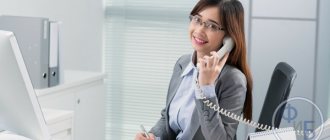Simplified reporting can be submitted by small businesses, non-profit organizations and participants in the Skolkovo project that are not subject to the restrictions established by clause 5 of Art. 6 of the Federal Law of December 6, 2011 No. 402-FZ. Simplified reporting forms used for the 2021 report are contained in Appendix No. 5 of Order No. 66n of the Ministry of Finance of the Russian Federation dated July 2, 2010 (as amended on April 19, 2019). Line codes in the simplified financial statements of the company are indicated independently. We will tell you what is included in each indicator and how to choose the necessary encoding for it.
Where are the line codes?
Indicators about the company's activities are grouped into consolidated items reflected in the reporting. All information is provided in a generalized form. According to clause 5 of Order No. 66n, in simplified financial statements, the organization enters line codes independently. The numerical value chosen by the company must correspond to the prevailing indicator in the specific weight in the completed article of each form. Line codes in simplified financial statements for 2021 are selected from Appendix No. 4 to Order No. 66n.
Consultant's blog
Content
hide
1 Basic financial statements
2 Cash and accrual basis
3 Balance
4 Statement of financial results (P&L) 4.1 Relationship between the income statement and the balance sheet
5 Cash flow statement (CFDS, CF) 5.1 What is the usefulness of the report?
6 Results
Basic financial reports
As soon as we talk about finances, managers and owners remember three basic financial reports that are a must have for any business. But unfortunately, the majority of them do not know how to properly analyze and compile them, and sometimes invent their own forms of these reports, which they consider the only correct ones.
These three types of reports are:
- Balance
- Financial result report
- Cash flow statement
Each of these reports is compiled according to a specific methodology and displays some useful information for users of these reports.
The balance sheet displays the financial position of a company as of a specific date, the income statement displays the company's performance for a specific period, and the cash flow statement displays the directions and flows of a business's cash flows.
Cash and accrual method
Before we start looking at each report separately, I would like to remind you that there are two ways to record income and expenses: accruals and cash.
Why do I remember this? Yes, because many entrepreneurs consider their financial results using the cash method, which is fundamentally wrong.
Let's look at each method separately.
The difference between these methods lies in the method of reflecting income and expenses for the selected accounting period. Those. in which business transactions for the period are considered expenses and which are income. It is clear that during the entire existence of the enterprise, all receipts of money are income, and all payments are expenses. But we are not interested in the entire working time, but in each specific period. Quarter, month, week or even day. When we divide our time line into segments, the difference arises.
Under the cash method, income is considered to be any receipt of funds in the cash register or to a current account, and expenses are any payment or disbursement made during the accounting period. In this case, the relationship between income and expenses for the same period does not matter. We bought vodka, sold an hour of karaoke - it’s still income and expense.
Under the accrual method, income for a period is considered to be the sales value of goods sold and services provided in this period, regardless of their payment. And an expense is considered to be the cost of goods and services sold, as well as the enterprise’s consumption of goods and services, and also regardless of their payment to the supplier. Those. if Borscht is income, then everything related to this Borscht is considered an expense - food, cook’s salary, hall rent, electricity, etc. Those. everything that led to the opportunity to realize this particular Borscht.
Which method is better?
It depends on situation.
The cash method is easier to implement because... is based on data from payment systems, which is very easy to collect - they are reflected in the cash register or banking system and are always confirmed by primary documents. In addition, the result of this method - profit - coincides with the cash balance, i.e. can be easily verified (by cash count).
The accrual method is more complicated, and its profit does not coincide with the cash balance, but it is more accurate in the sense that if the profitability or efficiency of the enterprise is calculated by the profit received, then it makes more sense, because income, expense and profit are interrelated.
Read: Systematic approach to financial management: areas of decision making and the impact of management decisions on financial reporting
The difference between them can be illustrated by the example of gasoline consumption in a car. Gas mileage is something we use to measure the “efficiency” of a car (and driving style). The lower the gas mileage, the better.
The “accrual method” is when we compare the distance traveled during a period with the volume of gasoline consumed during the same period. For this we use the on-board computer. We can drive 100 km in one week and spend 7 liters (7 l/100km), and drive 1000 km in another week and spend 60 liters (6 l/100km). Obviously, in the second week we drove more economically or “more efficiently”.
The “cash method” is when we compare the distance traveled during a period with the volume of gasoline purchased (filled in the tank) during the same period. We can fill 50 liters in one week and drive 1 km (5000 l/100km), and the next week add another 1 liter and drive 100 km (1 l/100km). Obviously, the results are not comparable, they make no sense.
This leads to a very simple conclusion:
Profit is not equal to money in the cash register. To analyze the “money” indicator, a cash flow statement is used; to analyze the “profit” indicator, a profit and loss statement is used.
Balance
A balance sheet is a snapshot of your business as of a specific date. And shows the financial condition of the company.
What can you use balance for?
- Answer the question: where is the money? (on the account, in the product,….)
- You can see the results and balances, find out how much fixed assets, goods, debt we have;
- To calculate financial ratios;
- Determine the book value of the business.
In short, here's what you need to remember:
- In any business there is a balance;
- Assets = Liabilities;
- Assets show what belongs to the company, liabilities show the company’s debts;
A good balance is when:
- The balance sheet currency is growing;
- There are more current assets than non-current assets
- Equity capital is greater than debt capital
- The growth rate of debtors is the same as that of creditors.
The balance sheet itself has the following structure:
On the left side we see information about the assets the company has, while on the right side the sources of origin of these assets are deciphered. These sources can be either own or borrowed.
Equality of the balance is ensured by the fact that each accounting transaction is displayed on two accounting accounts, with one account as a debit and the other as a credit.
All transactions that are displayed in accounting can be divided into 4 types:
- The operation affects only assets: A+X-X=P
- The operation affects only liabilities: A = P+X-X
- The operation increases both assets and liabilities: A+X=P+X
- The operation reduces both assets and liabilities: A-X=P-X
At the same time, the balance sheet is very closely related to other financial reports and accumulates the results of other reports.
This connection lies in our accounting identity:
Assets = Equity – Equity Withdrawals + Income – Expenses
The financial result is included in the Balance Sheet item – “Retained Earnings”, which is included in equity capital.
And cash flow is nothing more than the difference between the Balance Sheet item “Cash” between the beginning and end of the period.
Statement of financial results (P&L)
This report has many names, but its essence is the same - displaying the financial results of activities for a certain period and deciphering the components of income and expenses.
What are the purposes of using this report?
- See the financial result and its components
- Calculate important financial ratios: marginality, profitability
- Calculate break-even point
- Have an idea of the value of the business
Read: Relative indicators of company profitability: margin, ROI
Briefly, the scheme for constructing this report can be presented as follows:
The income and expense items in the management income statement can be detailed to the required level, but the structure will remain the same.
This report is prepared on an accrual basis, and not on the basis of cash receipts or expenditures. If you calculate it based on money, then it is no longer P&L.
Let's take sales revenue for example. It is considered based on fulfilled obligations, upon shipment of goods, upon provision of services. Revenue is confirmed by acts of signed services or invoices. Revenue is shown excluding indirect taxes (for example, VAT).
What a manager needs to know about this report:
- This report must be completed;
- Income and expenses are shown on an accrual basis;
- The rule of periods should be followed: expenses are recognized simultaneously with the income for which they were incurred, especially with regard to the cost of inventories;
- Indirect taxes do not participate in the formation of the financial result (but this rule has exceptions)
Relationship between the income statement and the balance sheet
The income statement and balance sheet in no way replace each other, since they perform different functions. The balance sheet, as already mentioned, shows the financial position of the company at one time or another; it is a “snapshot” of the assets owned by the company. And the income statement shows the flow of profits for the period. There is a direct connection between the two reporting forms.
The income statement links the balance sheets at the beginning of the period and at the end of the reporting period. Thus, at the beginning of a new reporting period, the balance sheet shows the initial financial position of the company. After some time, an income statement is prepared, showing how much profit the company made during the period, and a balance sheet, reflecting the company's new financial position at the end of the period. This balance sheet shows the changes that have occurred since the previous balance sheet date.
Cash Flow Statement (CFDS)
Many managers do not understand that a company's profit is not necessarily related to the money it receives. Yes, ultimately the company must make a profit in monetary terms, and if you take a long enough period of time, the income statement and cash flow statement will show the same numbers.
To develop a company, money is needed, and if the company is actively developing, it may not be enough and it begins to actively look for it on the side. In order for a potential investor to understand where the company’s money comes from, the ODDS was invented. It shows how much money the company had at the beginning of the reporting period, how much it had at the end, and why the initial and final values are different.
The report itself is prepared on a cash basis. And this is the first report that the manager draws up, even before he even thinks about the reporting system.
Why is this report being prepared?
- to know how much money is in the business, to predict cash gaps and the need for financing;
- analyze the company's cash flows;
- trace the relationship between cash flow and profit.
The report itself has three standard sections:
- Cash flow from core activities;
- Cash flow from investing activities;
- Cash flow from financing activities
These sections can be interpreted as follows:
- The company received X UAH. from its main activity;
- she spent Y UAH on her development;
- the company borrowed Z UAH.
Classic financial ODDS can be compiled by two methods: direct and indirect.
The direct method lists all major cash flow items separately. Then the amounts of payments made are subtracted from cash receipts.
Read: Assessing business efficiency: main indicators
In the indirect method , net income is recorded and then adjusted in accordance with the data necessary to determine on its basis the amount of net cash flow received or expended from operating activities.
An example of an ODDS compiled by the indirect method
| Cash flows from operating activities | |
| Net profit | 3 000 000 |
| Adjustments: | |
| Depreciation and amortization | 125 000 |
| Provision for losses on accounts receivable | 20 000 |
| Profit from the sale of an object | (65 000) |
| 80 000 | |
| Increase in trade receivables | (250 000) |
| Inventory reduction | 325 000 |
| Reduction of accounts payable | (50 000) |
| 25 000 | |
| Cash received from operations | 3 105 000 |
| Cash flows from investing activities | |
| Acquisition of fixed assets | (500 000) |
| Proceeds from the sale of equipment | 35 000 |
| Net cash used in investing activities | (465 000) |
| Cash flows from financing activities | |
| Proceeds from the issue of ordinary shares | 150 000 |
| Proceeds from the issue of long-term debt obligations | 175 000 |
| Dividends paid | (45 000) |
| Net cash used in financing activities | 280 000 |
| Net increase in cash and cash equivalents | 2 920 000 |
| Cash and cash equivalents at the beginning of the period | 2 080 000 |
| Cash and cash equivalents at the end of the period | 5 000 000 |
Whatever method you use, the result will be the same. The indirect method provides a better understanding of how cash flow from operating activities differs from profit. In addition, it is easier to compose, which is why many companies use it.
Why is the report useful?
This report is of interest to many users. Since it helps to identify possible manipulations with financial reporting data. The data in this report is very easy to check by simply looking at the cash flow across the accounts. They simply cannot be made artificially. Therefore, if, when analyzing the statements, you see a significant increase in profit, which is not accompanied by a significant increase in cash flow, then you need to be wary and analyze the reasons for the increase in such profit.
If a company has a negative cash flow, this does not mean that it is unprofitable. The company just needs to look for additional financing for its business.
What a manager needs to remember about this report:
- You must have this report;
- Compilation rules: on a cash basis;
- This report should not contain the words: Income or expenses, there are receipts and payments of funds;
- The rest of the money is not profit. Don't look for it in your safe. Net cash flow is not a measure of how much a company makes
Results
We have looked at three basic financial statements that almost every company has. All of these reports are interconnected and are just top-level reports and are essentially the icing on the cake of your financial reporting system, which also includes operational and analytical reports.
When preparing reports, remember that it should be:
- Structural – reporting is a system, and it should be closely woven into the structure of your company.
- Sufficient - it should not be redundant.
- Valuable - it must be compiled if it is used, otherwise it is meaningless. There is no need to make a report for the sake of the report itself.
- Reliable – you must trust the figures in the reporting.
- Timely - detailing reports is good, but if it is done, and the need for it has disappeared, then such a report is not needed.
stroki_ofr.jpg
Indicators with a negative value are indicated in parentheses.
Report on the intended use of funds (OKUD 0710003)
The form is filled out by NPOs and firms that received targeted funds. Other companies do not need to submit these reports. The lines contained in this form do not need a detailed description, so we will provide a brief breakdown of the indicators in Table 3.
Examples of accounting codes
Accounting codes change approximately once a year. In addition, such codes differ in tax services and enterprises; accordingly, accounting reporting periods also differ from each other. Therefore, before filling out the documentation for the report and submitting it to a specific service, you should definitely check the data at the current time.
Examples of accounting reporting codes for 2012 (code numbers and their designations, respectively):
- 21 – quarterly report;
- 31 – report for six months;
- 33 – report for nine months;
- 34 – report for twelve months;
- 90 – report (in case of liquidation of an enterprise) for twelve months;
- 94 – report (in case of liquidation of an enterprise) for another period of time.
However, these codes were changed by legislation in 2013 and 2014. Accordingly, when filling out documents for this period, it is necessary to clarify the current data. Completing the codes correctly is a prerequisite.
stroki_otchet_o_celevom_ispolzovanii.jpg
Material information affecting the reliability of reporting is disclosed in separate lines or in additional appendices. The company makes its own decision about what data to provide in more detail. The company sets the code in its reporting according to the indicator that has the maximum value in the line of the form containing the combined data. An organization can refuse to use simplified forms by choosing full accounting reporting and enshrining this in its accounting policies.
What does the income statement show?
This report was previously called profit and loss and corresponded to Form 2 of the financial statements. Its indicators are very important, as they characterize the financial results of the organization for the reporting period .
It is submitted along with the balance sheet and gives a more detailed picture of the organization’s financial results for various types of activities, as well as other income and expenses of the organization.
Data is entered as of December 31 of the reporting year, as well as December 31 of the previous year, that is, it becomes possible to evaluate the profits and losses of the organization for the last two years.
When are financial statements submitted?
In addition to all the above types of reports, previously enterprises were required to submit intermediate reports. This requirement has now been removed for most businesses. Some of them still submit this documentation to the tax authorities. However, such a requirement does not mean that reporting at certain periods of time is not necessary. Any enterprise is required to maintain this kind of reporting without submitting it to tax collection services. In a six-month report, an enterprise must indicate the following results for a given period of time:
- The balance sheet held by the company.
- The results that the company has achieved financially.
- Changes in the capital of the enterprise.
- Movement and change in the amount of funds.
When preparing a nine-month report, an enterprise must provide the same data as in a six-month report. The only difference is the time period. These documents must be submitted to the tax service before a certain date specified in the legislation. The date must be confirmed before submitting documents.
Thus, when preparing reports to the tax office, it is necessary to clarify the changed codes entered in the required fields. This allows you to speed up inspection not only by government regulatory organizations, but also reduce the time for analyzing reports within the enterprise.




